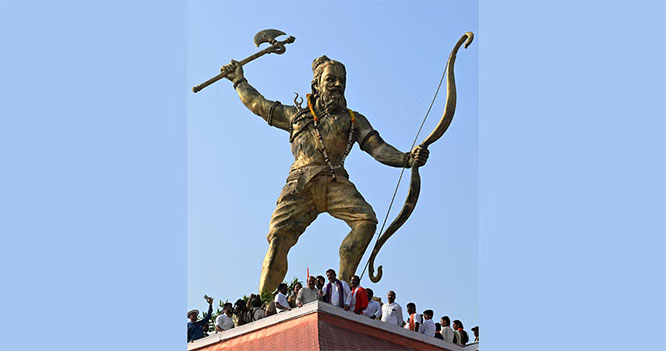Nationalism has been the matter of debate yet again. From last few years we saw the individuals being labeled as Anti National for criticizing the ruling Government, we witnessed the attack on JNU on the ground that it is breeding ground of anti-Nationals. At the same time those belonging to ‘Hindu nationalism’ have been presenting themselves as Nationalists. The shrewdness involved in this is that they have been hiding the prefix Hindu to the word, Nation. It is this prefix which shows that they in no way were part of the process of India becoming a nation. Indian Nation building has been a multi layered process. On one hand it was to oppose the colonial rule and simultaneously it was a journey towards democratic values.
This issue comes to fore yet again as Sant Tukdoji Maharaj Nagpur University has brought in a damaging change in their second year B.A. history course. The earlier chapter in the book was on the rise of communalism in India. That has been replaced by the chapter on ‘History of RSS and its role in Nation building’. The university spokesperson put it “Nationalist school of thoughts… is also part of the Indian history. Similarly, history of the Sangh is a part of the nationalist school. Hence, introduction to RSS was included in the course," On the other hand the state Congress spokesperson Sachin Sawant disputes this by saying, "Where would Nagpur University find reference of RSS & Nation Building? It is most divisive force which collaborated with British, opposed freedom movement, didn't hoist Tricolor for 52 years calling it inauspicious, wanted Manusmriti in lieu of constitution, spreads hatred."
What have been the components of India becoming a Nation? The earlier kingdoms were replaced by the colonial rule. The colonial phase was marked by introduction of major economic and social changes. These changes related to transport (railways), communication (Post and telegraph) modern education (Schools and universities), free press and modern judicial system among others. With these changes the social relations began to take place. The process of breaking of the ‘iron frame of caste structure’ began. The subordinate status of women was challenged as the likes of Savitribai Phule started schools for education for girls. The new class of Industrialists, modern businessmen and educated classes came up in the society. The political expression of these processes got reflected in multiple streams.
The major expression of this political phenomenon was the formation of Indian National Congress. The movements for breaking caste inequality were inspired by Joti Rao Phule and Babasaheb Ambedkar. The aspirations of workers got expressed in the unions led by Narayan Meghaji Lokhande and Com Singarvelu. Revolutionaries like Bhagat Singh stood against colonial rule with a dream of socialist society. This process of nation building has two sides. One was to express the social aspirations of these classes coming up in society; workers, women, educated classes, bureaucrats and industrialists in particular. The other was the political expression; the struggle against British colonialists.
To oppose these social-political changes section of declining classes, the kings and landlords and their fellow travelers, threw up their organizations. These organizations had two aspects. One was to oppose the social changes related to caste and gender transformation and second was to harp on nationalism in the name of religion. They were the ones who were opposed to the anti-British national movement. These declining sections had religion as a prefix of their nationalism. Their aims were purely political. Their political agenda was to preserve the birth based values of hierarchy, as manifested in feudal times.
Muslim League on one hand and Hindu Mahasabha-RSS on the other stood for Muslim and Hindu nationalism respectively. In case of Muslim League, Hindu Mahasabha, the religion is written on their sleeves, in case of RSS religion is the core part of their nationalism. Savarkar did work against caste system in patches, but mostly these organizations were totally aloof from the social changes related to caste and gender transformation. As far as freedom movement is concerned; as organizations they were never a part of any anti British movement. Individually pre-Andman Savarkar was anti British, but after his release his was a changed man. Similarly Dr. K. B. Hedgewar, RSS founder, as an individual did take part in 1930 Civil disobedience movement, but that was with the goal of finding like-minded workers in jail. As far as RSS is concerned, the instructions were given by Golwalkar, not to disturb the peace of British.
During Quit India movement the second Sarsanghchalak M.S. Golwalkar states, “In 1942 also there was a strong sentiment in the hearts of many. At that time too, routine work of Sangh continued. Sangh vowed not to do anything directly.” Defending his decision to keep aloof from the movement he says “We should remember that in our pledge we have talked of freedom of the country through defending religion and culture, there is no mention of departure of British from here.” (Shri Guruji Samagra Darshan, vol. IV, page 40) “
While Indian nationalism is inclusive and plural, as expressed in Indian Constitution, RSS has been eulogizing the ancient laws particularly those of Manu. Nationalism is not just the state and boundaries, it is the social relationships. In case of Indian nationalism these values are Liberty, Equality and Fraternity. ‘Nationalism under the garb of religion’, regards these values of equality as Western, not suitable for this or that country. For example Muslim Brotherhood in Egypt promotes feudal hierarchical values in the garb of Islam. It labels democratic values of equality, liberty as being Western ones’. RSS similarly regards Indian Constitution as being Western.
With these types of changes in our educational syllabus, the attempt is to present RSS as part of Indian nation building. This lie hides that RSS neither struggled against British rule nor for the democratic values of equality. The efforts like change in syllabus are attempts to give legitimacy to RSS as Indian nation builder, which they are not.





Comments
Add new comment